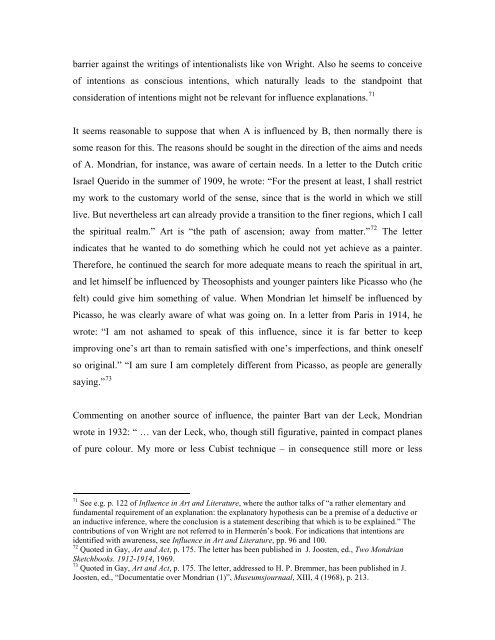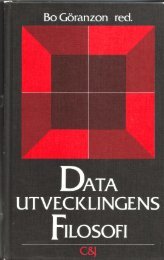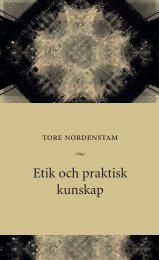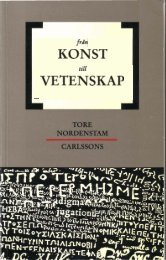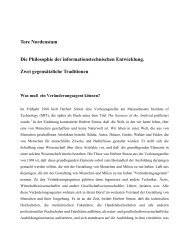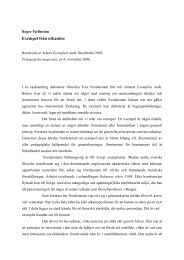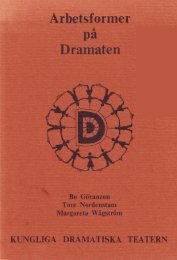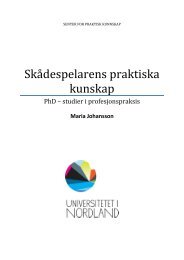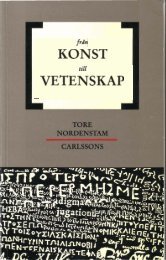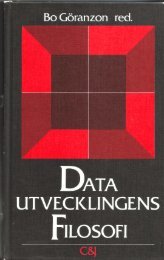tore nordenstam explanation and understanding in the history of art
tore nordenstam explanation and understanding in the history of art
tore nordenstam explanation and understanding in the history of art
Create successful ePaper yourself
Turn your PDF publications into a flip-book with our unique Google optimized e-Paper software.
arrier aga<strong>in</strong>st <strong>the</strong> writ<strong>in</strong>gs <strong>of</strong> <strong>in</strong>tentionalists like von Wright. Also he seems to conceive<br />
<strong>of</strong> <strong>in</strong>tentions as conscious <strong>in</strong>tentions, which naturally leads to <strong>the</strong> st<strong>and</strong>po<strong>in</strong>t that<br />
consideration <strong>of</strong> <strong>in</strong>tentions might not be relevant for <strong>in</strong>fluence <strong>explanation</strong>s. 71<br />
It seems reasonable to suppose that when A is <strong>in</strong>fluenced by B, <strong>the</strong>n normally <strong>the</strong>re is<br />
some reason for this. The reasons should be sought <strong>in</strong> <strong>the</strong> direction <strong>of</strong> <strong>the</strong> aims <strong>and</strong> needs<br />
<strong>of</strong> A. Mondrian, for <strong>in</strong>stance, was aware <strong>of</strong> certa<strong>in</strong> needs. In a letter to <strong>the</strong> Dutch critic<br />
Israel Querido <strong>in</strong> <strong>the</strong> summer <strong>of</strong> 1909, he wrote: “For <strong>the</strong> present at least, I shall restrict<br />
my work to <strong>the</strong> customary world <strong>of</strong> <strong>the</strong> sense, s<strong>in</strong>ce that is <strong>the</strong> world <strong>in</strong> which we still<br />
live. But never<strong>the</strong>less <strong>art</strong> can already provide a transition to <strong>the</strong> f<strong>in</strong>er regions, which I call<br />
<strong>the</strong> spiritual realm.” Art is “<strong>the</strong> path <strong>of</strong> ascension; away from matter.” 72 The letter<br />
<strong>in</strong>dicates that he wanted to do someth<strong>in</strong>g which he could not yet achieve as a pa<strong>in</strong>ter.<br />
Therefore, he cont<strong>in</strong>ued <strong>the</strong> search for more adequate means to reach <strong>the</strong> spiritual <strong>in</strong> <strong>art</strong>,<br />
<strong>and</strong> let himself be <strong>in</strong>fluenced by Theosophists <strong>and</strong> younger pa<strong>in</strong>ters like Picasso who (he<br />
felt) could give him someth<strong>in</strong>g <strong>of</strong> value. When Mondrian let himself be <strong>in</strong>fluenced by<br />
Picasso, he was clearly aware <strong>of</strong> what was go<strong>in</strong>g on. In a letter from Paris <strong>in</strong> 1914, he<br />
wrote: “I am not ashamed to speak <strong>of</strong> this <strong>in</strong>fluence, s<strong>in</strong>ce it is far better to keep<br />
improv<strong>in</strong>g one’s <strong>art</strong> than to rema<strong>in</strong> satisfied with one’s imperfections, <strong>and</strong> th<strong>in</strong>k oneself<br />
so orig<strong>in</strong>al.” “I am sure I am completely different from Picasso, as people are generally<br />
say<strong>in</strong>g.” 73<br />
Comment<strong>in</strong>g on ano<strong>the</strong>r source <strong>of</strong> <strong>in</strong>fluence, <strong>the</strong> pa<strong>in</strong>ter B<strong>art</strong> van der Leck, Mondrian<br />
wrote <strong>in</strong> 1932: “ … van der Leck, who, though still figurative, pa<strong>in</strong>ted <strong>in</strong> compact planes<br />
<strong>of</strong> pure colour. My more or less Cubist technique – <strong>in</strong> consequence still more or less<br />
71<br />
See e.g. p. 122 <strong>of</strong> Influence <strong>in</strong> Art <strong>and</strong> Literature, where <strong>the</strong> author talks <strong>of</strong> “a ra<strong>the</strong>r elementary <strong>and</strong><br />
fundamental requirement <strong>of</strong> an <strong>explanation</strong>: <strong>the</strong> explanatory hypo<strong>the</strong>sis can be a premise <strong>of</strong> a deductive or<br />
an <strong>in</strong>ductive <strong>in</strong>ference, where <strong>the</strong> conclusion is a statement describ<strong>in</strong>g that which is to be expla<strong>in</strong>ed.” The<br />
contributions <strong>of</strong> von Wright are not referred to <strong>in</strong> Hermerén’s book. For <strong>in</strong>dications that <strong>in</strong>tentions are<br />
identified with awareness, see Influence <strong>in</strong> Art <strong>and</strong> Literature, pp. 96 <strong>and</strong> 100.<br />
72<br />
Quoted <strong>in</strong> Gay, Art <strong>and</strong> Act, p. 175. The letter has been published <strong>in</strong> J. Joosten, ed., Two Mondrian<br />
Sketchbooks. 1912-1914, 1969.<br />
73<br />
Quoted <strong>in</strong> Gay, Art <strong>and</strong> Act, p. 175. The letter, addressed to H. P. Bremmer, has been published <strong>in</strong> J.<br />
Joosten, ed., “Documentatie over Mondrian (1)”, Museumsjournaal, XIII, 4 (1968), p. 213.


